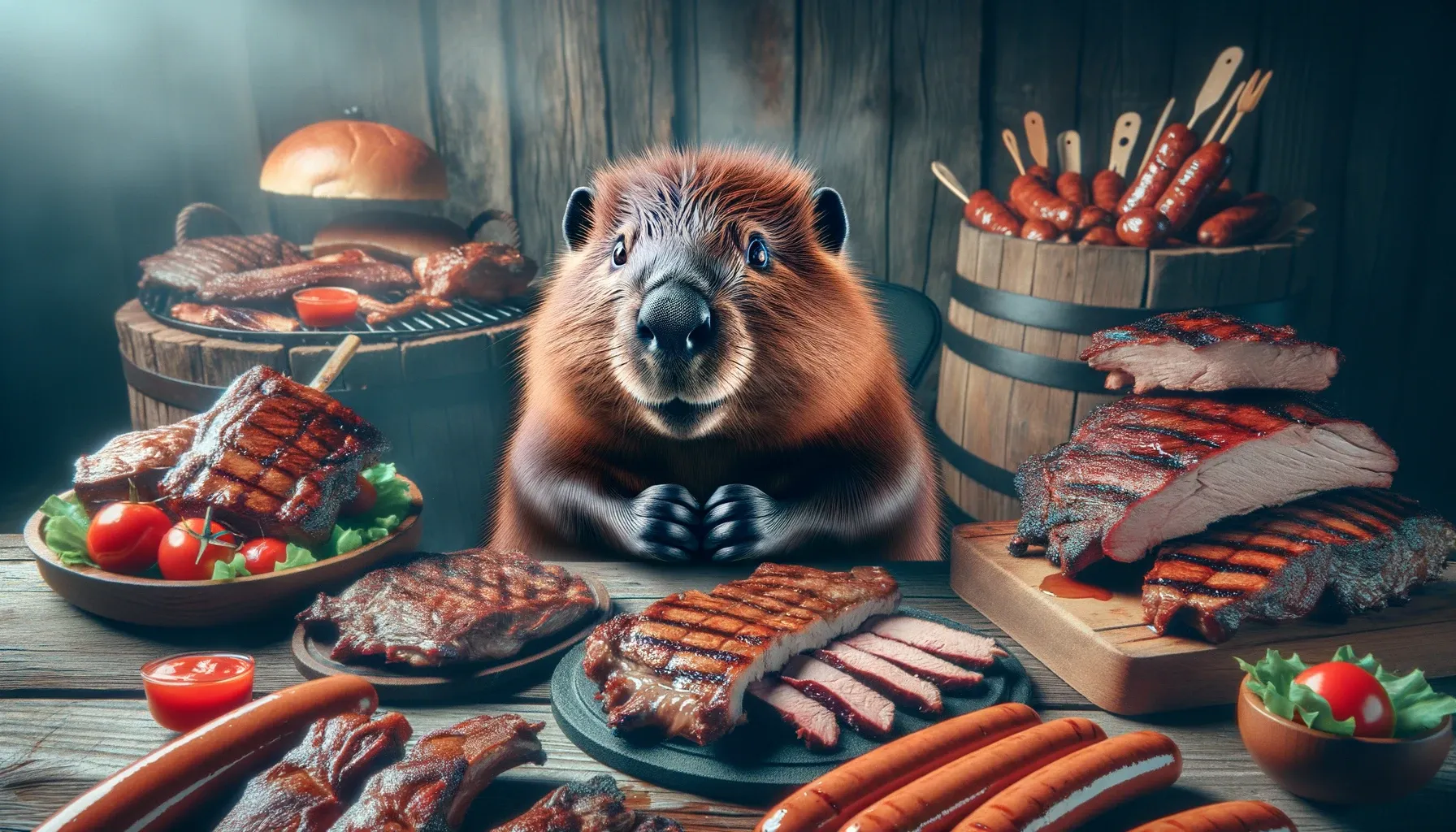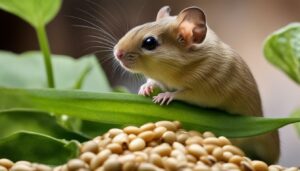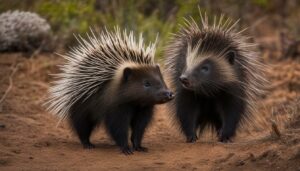Beavers are fascinating creatures, but have you ever wondered if they eat meat? In this article, we will explore the dietary habits of beavers and find out if they are carnivorous, herbivorous, or omnivorous.
Key Takeaways:
- Beavers are strict vegetarians and do not eat meat or animal-derived foods.
. - Their diet consists of a variety of vegetation, including aquatic plants, soft vegetation, twigs, berries, fruits, and inner tree bark.
. - Beavers prefer woody plants during winter and consume more aquatic plants during the warmer months.
. - There is a common misconception that beavers eat meat, but they are strictly herbivores.
. - Beavers play an important role in shaping the wilderness through their feeding habits and dam-building activities.
The Diet of Beavers
Beavers have a diverse diet that primarily consists of plant matter. These herbivorous creatures are remarkable for their ability to adapt to different environments and find suitable vegetation to sustain themselves.
Let’s take a closer look at the dietary preferences of beavers and the types of food they consume.
Preferred Food
Aquatic Plants: Beavers are well-known for their love of aquatic plants. They skillfully dive into water bodies to harvest aquatic vegetation like water lilies, pondweed, and cattails.
These plants provide essential nutrients and are a vital component of their diet.
Soft Vegetation: Besides aquatic plants, beavers also consume various soft vegetation found on land. This includes grasses, sedges, and other herbaceous plants.
They graze on these plants, helping to maintain a balanced ecosystem by preventing overgrowth in wetland areas.
Twigs, Berries, Fruits, and Inner Tree Bark: Beavers are ingenious in their use of resources. They not only eat the leaves and buds of young trees but also feed on twigs and inner tree bark.
In addition, beavers have been known to enjoy berries and fruits, especially during the warmer months when these food sources are abundant.
Misconceptions
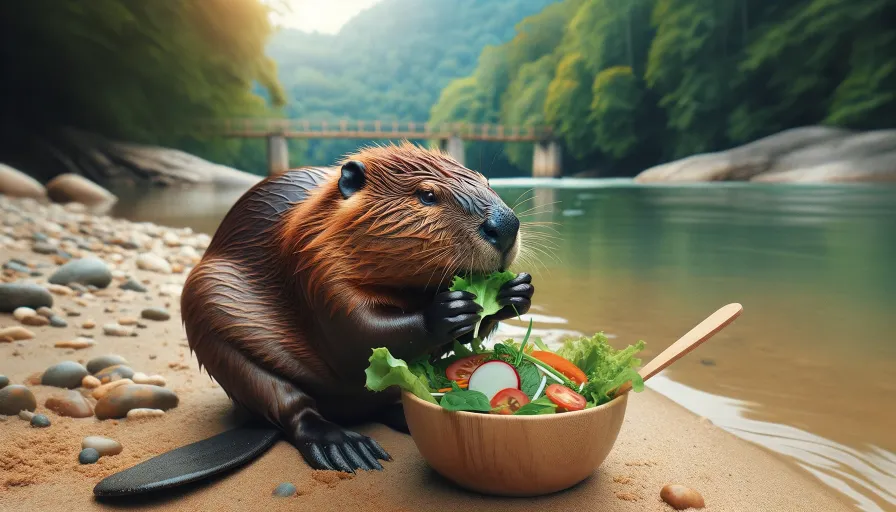
Despite their reputation for being voracious builders and powerful swimmers, beavers do not eat meat. It is a common misconception that they are carnivorous or omnivorous due to their resemblance to otters and groundhogs, which have different dietary preferences.
Beavers are strictly herbivores and rely solely on plant matter to meet their nutritional needs.
| Preferred Food | Seasonal Changes | Misconceptions |
|---|---|---|
| Aquatic Plants | Winter – Woody Plants | Strictly Herbivorous |
| Soft Vegetation | Warmer Months – Aquatic Plants | |
| Twigs, Berries, Fruits, Inner Tree Bark |
Vegetation in the Beaver’s Diet
A significant portion of a beaver’s diet is made up of various types of vegetation. Beavers are herbivores and rely solely on plant matter for their nutritional needs.
They consume a wide range of vegetation, including aquatic plants, soft vegetation, twigs, berries, fruits, and inner tree bark.
Beavers are known for their ability to manipulate their environment to obtain their preferred food sources.
They are excellent swimmers and are often found in freshwater habitats where they can access a variety of aquatic plants.
These plants, such as water lilies and pondweed, make up a substantial part of their diet and provide essential nutrients.
In addition to aquatic plants, beavers also feed on a range of terrestrial vegetation. They chew on twigs and branches, stripping the bark and consuming the inner layers.
This behavior not only provides them with nutrition but also helps them maintain healthy teeth, which grow continuously throughout their lives.
Table: Examples of Vegetation Consumed by Beavers
| Plant Type | Examples |
|---|---|
| Aquatic Plants | Water lilies, pondweed, cattails |
| Soft Vegetation | Grasses, sedges, ferns |
| Twigs | Willow, poplar, birch |
| Berries | Blackberries, raspberries, elderberries |
| Fruits | Apples, pears, plums |
| Inner Tree Bark | Cambium layer of various tree species |
These diverse food sources ensure that beavers receive the necessary nutrients for their survival and reproduction.
It is important to note that despite their appearance resembling otters and groundhogs, beavers do not consume meat or animal-derived foods.
They have evolved as strict vegetarians and have a unique feeding behavior that revolves around their herbivorous diet.
By understanding the vegetation consumed by beavers, we can gain insight into their ecological role as ecosystem engineers.
The plants they consume and manipulate contribute to shaping the habitats they inhabit and play a vital role in maintaining the balance of the surrounding wilderness.
Beavers truly exemplify the adaptability and resourcefulness of herbivorous animals in nature.
Seasonal Changes in Food Preferences

The beaver’s diet adapts and shifts according to the seasons. As herbivores, beavers have a diverse array of plant-based options to choose from, based on availability and nutritional needs.
During the winter months, when their usual food sources are scarce, beavers have a preference for woody plants.
These include the inner bark of trees, which is rich in nutrients and serves as a valuable food source for survival during the colder seasons.
In contrast, as the weather warms up and vegetation becomes more abundant, beavers increase their consumption of aquatic plants.
These include water lilies, pondweeds, and cattails, which thrive in wetland habitats. These plants not only provide essential nutrients but also serve as a major source of hydration for beavers during the hot summer months.
The beaver’s diet during this time is primarily composed of these aquatic plants, enabling them to thrive in their natural habitat.
Table: Examples of Beaver’s Seasonal Food Preferences
| Season | Preferred Food |
|---|---|
| Winter | Woody plants (inner tree bark) |
| Spring | Aquatic plants (water lilies, pondweeds) |
| Summer | Aquatic plants (cattails) |
It is important to note that beavers do not consume meat or animal-derived products. This is a common misconception due to their appearance and resemblance to carnivorous or omnivorous animals.
However, beavers are strictly herbivores and rely solely on plant matter for their nutritional needs. Their ability to adapt their diet based on seasonal changes ensures their survival and success in their natural habitat.
Misconceptions about Beaver’s Meat Consumption
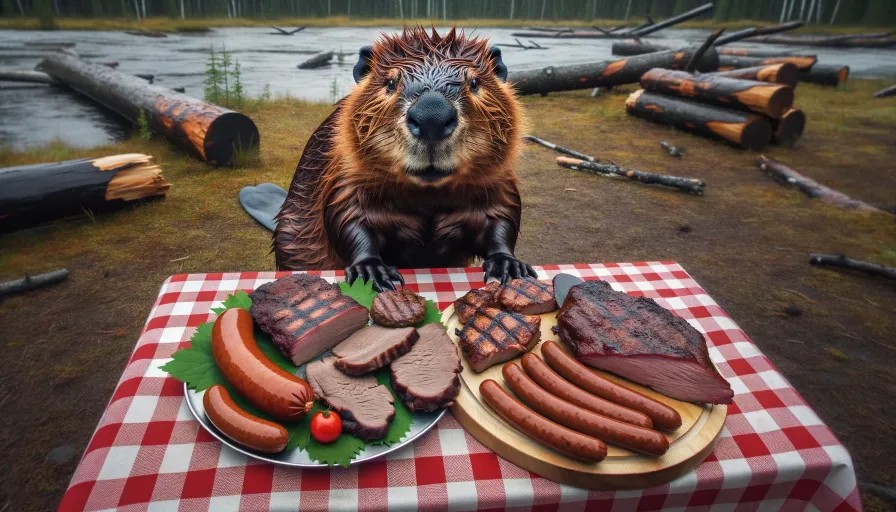
Despite their appearance and resemblance to other carnivorous animals, beavers are not meat-eaters.
Their diet consists solely of plant matter, making them strict herbivores. This may come as a surprise to some due to their aquatic lifestyle and strong incisors, which are often associated with meat consumption.
Beavers primarily feed on a variety of vegetation, including aquatic plants, soft vegetation, twigs, berries, fruits, and inner tree bark.
These food sources provide the necessary nutrients for their survival and help them meet their nutritional needs.
Their preference for different types of vegetation varies by season, with woody plants being favored during the winter months when other food sources are scarce.
It is important to dispel the misconception that beavers are carnivorous or omnivorous. This misunderstanding may stem from their physical similarities to otters and groundhogs, which are known to consume meat.
However, beavers are unique in their dietary preferences and rely solely on plant matter for sustenance.
The Beaver’s Diet: Fact vs. Fiction
- Fiction: Beavers are meat-eaters.
- Fact: Beavers are strict herbivores and do not consume meat or animal-derived foods.
- Fiction: Beavers have a mixed diet of both plants and meat.
- Fact: Beavers rely solely on plant matter, including aquatic plants, twigs, fruits, and inner tree bark, to meet their nutritional needs.
- Fiction: Beavers resemble other carnivorous or omnivorous animals in their feeding habits.
- Fact: Despite their resemblance, beavers are unique herbivores and have specific dietary preferences that differ from carnivorous or omnivorous animals.
Understanding the true nature of a beaver’s diet is crucial in appreciating their role in the ecosystem. By consuming vegetation and contributing to the shaping of their environment through dam-building activities, beavers play a vital part in maintaining the balance of the wilderness.
| Vegetation | Season | Quantity Consumed |
|---|---|---|
| Woody Plants | Winter | High |
| Aquatic Plants | Warmer Months | Increased |
| Soft Vegetation, Twigs, Berries, Fruits | Throughout the Year | Varies |
| Inner Tree Bark | Year-round | Essential |
Unique Feeding Behavior
Beavers exhibit fascinating feeding behavior that involves tree-felling and dam-building. These activities are crucial for their survival and ecosystem maintenance.
With their sharp incisors, beavers can skillfully gnaw through trees, creating a valuable resource for their diet. By felling trees, they can access the inner bark, a nutritious food source.
Additionally, beavers construct elaborate dams using branches, logs, and mud. These structures serve multiple purposes.
Firstly, dams create deep ponds, enabling beavers to build lodges for shelter. Secondly, the ponds created by these dams provide a safe habitat for aquatic vegetation, which beavers heavily rely on for sustenance.
The damming behavior also helps regulate water flow, reducing erosion and enriching nearby wetlands.
It is important to note that beavers are highly selective in their choice of trees. They prioritize certain species, such as aspen and willow, due to their palatable bark and shoots.
While beavers primarily consume vegetation, they may occasionally use small animal matter, like insects or fish, for scent marking or territorial defense purposes, rather than as a significant food source.
| Beaver Feeding Behavior | |
|---|---|
| Feeding Actions | Tree-felling, gnawing, dam-building |
| Preferred Trees | Aspen, willow |
| Food Sources | Vegetation (aquatic plants, soft vegetation, twigs, berries, fruits, inner tree bark) |
| Occasional Use of Animal Matter | Insects, fish (for scent marking and territorial defense) |
By understanding the unique feeding behavior of beavers, we can appreciate their vital role in shaping and maintaining ecosystems.
As ecosystem engineers, they significantly impact the availability of water, the diversity and abundance of plant life, and the overall health of wetland habitats.
Through their remarkable adaptation and feeding strategies, beavers exemplify the remarkable harmony between animals and nature.
Impact on the Wilderness
Beavers have a significant impact on the ecosystem due to their feeding habits and dam construction.
These activities play a crucial role in shaping the wilderness and creating diverse habitats for other species.
By selectively felling trees, beavers create open areas that allow sunlight to reach the forest floor, promoting the growth of a variety of vegetation.
This helps to enhance biodiversity by providing food and shelter for numerous plant and animal species.
Not only do beavers alter the landscape through their feeding behavior, but their dam-building activities also have far-reaching effects.
The construction of dams creates a series of ponds and wetlands, which serve as important habitats for many aquatic organisms.
These habitats support a wide range of plant and animal species, including amphibians, fish, waterfowl, and invertebrates.
The intricate network of waterways created by beaver dams also helps to regulate water flow, preventing flooding and erosion, and promoting groundwater recharge.
Beaver Ponds: A Biodiversity Hotspot
Beaver ponds can be considered biodiversity hotspots due to the unique ecological conditions they create.
The shallow, nutrient-rich water in these ponds supports the growth of a variety of aquatic plants, such as water lilies and cattails.
These plants provide food and shelter for many invertebrates and fish species. The presence of beavers and the resulting pond ecosystems attract a diverse range of wildlife, including birds, mammals, and reptiles.
The beaver pond ecosystem supports a complex web of interactions between different species. For example, the nutrient-rich sediments in beaver ponds provide an abundant food source for bacteria and other decomposers, which in turn support the growth of algae and other microorganisms.
These microorganisms are then consumed by invertebrates, which are in turn preyed upon by fish and birds.
The interconnectedness of the beaver pond ecosystem highlights the crucial role that beavers play in maintaining biodiversity and ecosystem health.
| Beaver Impact on the Wilderness | Benefits |
|---|---|
| Vegetation enhancement | Promotes diversity and provides food and shelter |
| Habitat creation | Supports a wide range of plant and animal species |
| Water flow regulation | Prevents flooding and erosion, promotes groundwater recharge |
| Biodiversity hotspot | Sustains complex ecological interactions and supports diverse wildlife |
The Nutritional Needs of Beavers
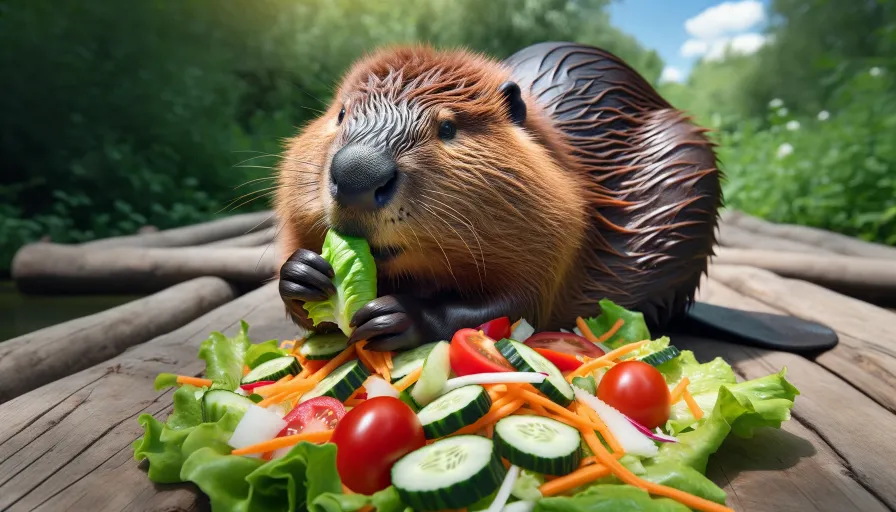
Beavers are able to meet their nutritional requirements by consuming a variety of plant matter. As herbivores, their diet primarily consists of vegetation found in their aquatic habitats.
Aquatic plants, such as water lilies and cattails, make up a significant portion of their diet, providing essential nutrients and fiber.
In addition to aquatic plants, beavers also consume a range of other vegetation. They will feed on soft vegetation, including grasses and sedges, as well as twigs, berries, fruits, and inner tree bark.
This diverse diet ensures that beavers obtain the necessary nutrients, vitamins, and minerals needed for their survival.
Seasonal changes play a role in the beaver’s food preferences. During the winter months when other food sources are scarce, beavers rely heavily on woody plants.
These woody plants, such as aspen and willow, provide the beaver with both sustenance and the material required for dam-building.
In the warmer months, beavers consume larger quantities of aquatic vegetation due to its abundance.
| Preferred Food | Season |
|---|---|
| Woody Plants | Winter |
| Aquatic Plants | Warmer Months |
It is important to dispel the misconception that beavers are carnivorous or omnivorous. While they may bear some resemblance to carnivorous mammals like otters and groundhogs, beavers are strictly herbivorous.
Their digestive system is adapted to process plant matter, and they lack the necessary enzymes to digest meat or animal-derived foods. Therefore, beavers rely solely on their vegetable diet to fulfill their nutritional needs.
Beavers vs. Other Carnivorous Animals
While beavers may resemble other carnivorous or omnivorous animals, their diet is distinctively herbivorous.
Unlike their meat-eating counterparts, beavers are strict vegetarians and do not consume any meat or animal-derived foods.
Their digestive systems are uniquely adapted to extract nutrients from plant matter, making them entirely reliant on vegetation for their nutritional needs.
Beavers have a diverse diet that includes a variety of plant-based foods. They primarily feed on aquatic plants, such as water lilies and pondweed, which make up a significant portion of their diet.
Additionally, beavers consume soft vegetation, twigs, berries, fruits, and the inner bark of trees. Their feeding preferences change with the seasons, with woody plants being a preferred choice during winter for their higher nutrient content, while aquatic plants are consumed in larger quantities during the warmer months.
It is often misconstrued that beavers eat meat due to their physical resemblance to carnivorous or omnivorous animals like otters and groundhogs.
However, this misconception stems from their similar appearance rather than their dietary habits. Beavers are strict herbivores and do not partake in the consumption of animal flesh or other animal-derived foods.
| Beaver Diet | |
|---|---|
| Aquatic Plants | Water lilies, pondweed |
| Soft Vegetation | Grasses, sedges |
| Twigs | Willow, aspen |
| Berries and Fruits | Raspberries, apples |
| Inner Tree Bark | Maple, birch |
Beavers’ strict herbivorous diet has played a significant role in shaping their feeding behavior and the impact they have on their environment.
By selectively consuming certain vegetation, beavers contribute to the growth and diversity of plant life, while their dam-building activities create habitats for a variety of other species.
These unique feeding behaviors are essential for maintaining a balanced ecosystem in wilderness areas where beavers are found.
Conclusion
Beavers are fascinating creatures with a herbivorous diet, playing an important role in shaping our wilderness.
Despite their resemblance to carnivorous or omnivorous animals like otters and groundhogs, beavers are strict vegetarians and do not consume meat or animal-derived foods.
Instead, their diet consists of a diverse range of vegetation.
Beavers are known to consume aquatic plants, soft vegetation, twigs, berries, fruits, and inner tree bark.
Their food preferences vary with the seasons, with woody plants being a favorite during winter when other food sources are scarce.
In the warmer months, beavers consume larger quantities of aquatic plants to meet their nutritional needs.
It is important to address the common misconception that beavers eat meat. Despite their carnivorous appearance, beavers rely solely on plant matter for their nutrition.
This distinction sets them apart from other animals in the same family and reinforces their status as herbivores.
With their unique feeding behavior, including the ability to fell trees and build dams, beavers shape the landscape of our wilderness.
By constructing dams and creating ponds, they create habitats for a variety of plant and animal species, contributing to the overall biodiversity of ecosystems.
Their diet, consisting of vegetation, showcases their adaptability and resourcefulness as they navigate various seasons and contribute to the overall health and balance of ecosystems.
FAQ
Do beavers eat meat?
No, beavers are strict vegetarians and do not eat meat or animal-derived foods.
What is the diet of beavers?
Beavers’ diet consists of a variety of vegetation, including aquatic plants, soft vegetation, twigs, berries, fruits, and inner tree bark.
Do the food preferences of beavers change with the seasons?
Yes, beavers have different food preferences based on the season. They favor woody plants during winter and consume larger quantities of aquatic plants during the warmer months.
Are there misconceptions about beavers eating meat?
Yes, there is a common misconception that beavers eat meat due to their resemblance to otters and groundhogs, which are carnivorous or omnivorous. However, beavers are herbivores and rely solely on plant matter for their nutritional needs.
What is unique about the feeding behavior of beavers?
Beavers have the capability to fell trees and build dams as part of their feeding strategy. This behavior is unique to their species.

